The Intel Skylake Mobile and Desktop Launch, with Architecture Analysis
by Ian Cutress on September 1, 2015 11:05 PM ESTIf you read our review of the Skylake-K processors, you will note that in terms of clock-for-clock performance, Skylake was not as big of a jump as people were perhaps expecting, affording an average of 5.7% over Haswell and 2.7% over Broadwell. For an architecture change, users (us included) have come to expect a 5-10% generation on generation increase at the same frequency. So by getting these results, we started to point some fingers and questions at Intel regarding the architecture due to the fact that in a change from previous launches this information was to be provided post-launch. That time was IDF, and while Intel did get somewhat technical, there are still some questions hanging in the air. In the meantime, this is what we learned. For this page, we’re focusing purely on performance, with power considerations a few pages further on.
Do More On The Fly
There are many different metrics and underlying on-paper ways to increase performance. Being able to process commands and data in fewer cycles, or by handling/processing more data at once, are two very important ones. Intel tries to tackle both within the out-of-order architecture.
Instruction level parallelism is one of the holy grails in processor design – if you are able to separate a set of code into X instructions and process all X at once (due to a lack of dependencies), then the problem is cracked. The downside is that a lot of code and as a result, a lot of instructions, rely on other instructions and data. The best bit about an out-of-order architecture is that when many different branches of code and instructions are in flight at once, they can be grouped up in the scheduler and a level of instruction parallelism can be achieved.
So first up is the OoO window, increasing 16.7% over Haswell. This allows the micro-ops (Intel’s version of deconstructing the instructions) to fill the queue and be arranged such that more parallelism can take place. This also takes advantage of in-flight loads and stores such that data can be available by the time the micro-op gets to the front of that queue. The idea is that heavy workloads that are interchangeable but require data access stalls can take advantage and hide the latency associated with those stalls, as well as allowing certain operations to be fused in order to reduce the workload.
With the micro-ops, Intel has upgraded the front end of the IA core to allow a dispatch of six micro-ops at once, up from four on Haswell. This allows the queue to be quicker, but also the dispatch of micro-ops from the queue to the execution units has increased to six also. Note that the execution units are limited by the number of INT/FP/Load/Store available, so it is the job of the queue to reorder the micro-ops to take advantage of this, as well as manage the memory accesses.
The front-end (uOp allocation and up) is designed to take advantage of better branch prediction and faster prefetch, as well as the increased in-flight buffers as mentioned above. Branch prediction is also another element to increasing processor performance here – in some circumstances the CPU will speculate as to the instruction required and then dump the result it doesn’t need. Too much speculation wastes power, but not enough will result in increased processing time and latency. So the branch predictor acts as a secret sauce for a lot of core design, but we are told that Skylake improves this.
On the front end, there are some small adjustments in the execution units with regards latency – the divider is improved, which is normally a difficult set of commands to optimize and calculated via an improved radix. Typically when writing scientific calculation code for example, it is often suggested to minimize divisions where possible. On the other side of the coin, the FMUL (floating point multiply) has increased in latency over Broadwell, and returned to the same as Haswell. We are told that this is due to design decisions that allows for better performance when it comes to creating enterprise silicon, which is an interesting explanation in itself. The execution units also have a greater degree of granularity in their power modes, allowing those not active to save power.
One element we did not mention in our original Skylake review (because we didn’t notice, I’ll be honest), is that the L2 cache on Skylake is reduced from an 8-way associative cache to a 4-way model. This is odd for Intel, given that as far back as Sandy Bridge, they have always worked with an 8-way L2. In real world terms, this relates to how the L2 data is stored and accessed, where a doubling in the associativity often reduces the miss rate depending on the algorithm. However, reducing the associativity saves power on data accesses that are successful and in some circumstances can also save area on the silicon die. So by moving from 8-way to 4-way, Intel saves some power with Skylake but loses some performance if you compare two identical silicon models. Intel counters this move by saying that the bandwidth to the L2 cache misses is doubled, as well as improving how cache and page misses are handled providing a lower latency for that data. The end result should be performance similar to that in Haswell, but at a lower power. We were also told that this has benefits when designing the server processor line, although we will have to wait and see exactly why.
Another element to the back-end results in improved HyperThreading performance. In our benchmark data we have seen this, where for example the ratio of Cinebench single threaded performance to multi-threaded performance was better than previous generations. Part of the HT improvements relate to micro-op retirement – basically being able to abandon used operations and free up the execution queue. When I heard this, my first question was if instruction retirement was ever a bottleneck – would you ever be in a position where you have all the data you need to process an instruction but because the older instruction is not cleared, the new instruction cannot be processed? Apparently the answer is yes, and the new design allows each thread in a core to retire four micro-ops in one cycle. This should mean that HyperThreading yields some tangible benefits when it comes to intensive workloads (again, another nod to the enterprise performance crowd).
Ultimately, from a pure core design point of view, Skylake looks a lot like Haswell with minor tweaks that are not instantaneously obvious. It can be hard to feel how ‘a deeper buffer’ can increase performance when the software being used barely filled the buffer in the first place. A lot of these improvements are aimed directly at the pure-performance perspective (except L2 and FMUL to an extent), so you really have to be gunning it or have a specific workload to take advantage.
It is at this point I should mention that Intel's policy of disclosing new architecture details seems to hold back more and more details each generation, such as pipeline length, branch misprediction penalties and exact adjustments to instruction throughput. For example, the FMUL adjustment in latency was only found when we asked about it based on a rumor we had heard. It seems that Intel might be willing to give the information if specific questions are asked, although other information needs to be investigated.
A side note on the enterprise based comments. In the first slide of the core front/back end, it states ‘dedicated server and client IP configurations’. As far as we can tell, this is a drive to make Intel’s processor/core designs more modular in nature such that being able to produce a custom processor for a certain enterprise market is easier to do. That being said, designing a core and working within design constraints can be a pain (you want registers and caches to be close to the queues to be close to the execution units and so on), so some optimization in a modular system still has to be made. It also makes us wonder to what level the modularity can take, and if some of the more esoteric designs might help Intel develop custom SoCs similar to AMD. It’s a thought.
Security Technologies
Along with the core upgrades, Intel is introducing both SGX (Security Guard Extensions) and MPX (Memory Protection Extensions) to Skylake.
This is in part similar to ARM’s TrustZone, or sandbox modes, whereby a program can be run in its own environment (or enclave is what Intel calls it) where it cannot interact outside the enclave and any attempt by other programs to access the memory in which it resides fails.
The MPX implementation is to aid buffer overflow errors that are a common source of security breaches.
eDRAM Changes
Until testing Broadwell-H and meeting up with certain individuals at IDF, the principle of the eDRAM Intel had been using was a little ill-defined. Sure we tested it when it launched, as well as the Broadwell processors, and commented that the obvious tasks to be improved came down to gaming on integrated graphics or very specific workloads. For Skylake, eDRAM enabled processors will be configured differently to previous versions in order to make the effect of the eDRAM more seamless for software.
This is the current eDRAM representation for Haswell and Broadwell processors. Here we see that the eDRAM is accessed by a store of L4 tags contained within the LLC of each core, and as a result acts more as a victim cache to the L3 rather than as a dynamic random access memory implementation. Any instructions or hardware that requires data from the eDRAM has to go through the LLC and do the L4 tag conversion, limiting its potential (although speeding up certain specific workloads by virtue of a 50 GB/s per-link bi-directional interface.
In Skylake, the eDRAM arrangement changes:
Rather than acting as a pseudo-L4 cache, the eDRAM becomes a DRAM buffer and automatically transparent to any software (CPU or IGP) that requires DRAM access. As a result, other hardware that communicates through the system agent (such as PCIe devices or data from the chipset) and requires information in DRAM does not need to navigate through the L3 cache on the processor. Technically graphics workloads still need to circle around the system agent, perhaps drawing a little more power, but GPU drivers need not worry about the size of the eDRAM when it becomes buffer-esque and is accessed before the memory controller is adjusted into a higher power read request. The underlying message is that the eDRAM is now observed by all DRAM accesses, allowing it to be fully coherent and no need for it to be flushed to maintain that coherence. Also, for display engine tasks, it can bypass the L3 when required in a standard DRAM access scenario. While the purpose of the eDRAM is to be as seamless as possible, Intel is allowing some level on control at the driver level allowing textures larger than the L3 to reside only in eDRAM in order to prevent overwriting the data contained in the L3 and having to recache it for other workloads.
As noted in the previous pages, the eDRAM from Intel will come in two flavors – 64 MB and 128 MB, which is different to the 128 MB only policy for Haswell and Broadwell. Back when Intel was discussing eDRAM before this, it was noted that Intel considered 32 MB ‘enough’, but doubled it and doubled it again just to make sure the system truly saw some benefit. It seems that for some circumstances (or some price points for that matter) 64 MB is felt as a better fit in that regard, given that Intel believes that its initial design had plenty of headroom. As far as we can tell, eDRAM will be available in 64MB for GT3e and 128MB for GT4e configurations (48 EUs and 72 EUs respectively), although we might see some variation as time goes on. We have confirmed with Intel that the 64 MB implementation is a half-silicon implementation (rather than a disabled full-silicon), but the bandwidth to the system agent is the same in both circumstances.
A number of media have already been requesting an announcement regarding a discrete processor with an eDRAM implementation, similar to Broadwell. I even enjoyed conversations at IDF where it was suggested that Intel could produce an i7 at 4.0 GHz with 128MB eDRAM, either with or without overclocking, and charge a nice $30-$50 premium for it. However, we were told that a quad core desktop part with eDRAM (either 4+2e or 4+4e) is currently not POR, which means ‘plan of record’. To avoid confusion, because technically a 3+2 is not on their ‘plan of record), having been mentioned as not POR means means that Intel has looked at it as an option but at this time has not decided to release it at this time - if they ever will is another question to ask Intel. For users who actively want an LGA1151 4+4e configuration, make sure your Intel representative knows it, because customer requests travel up the chain.



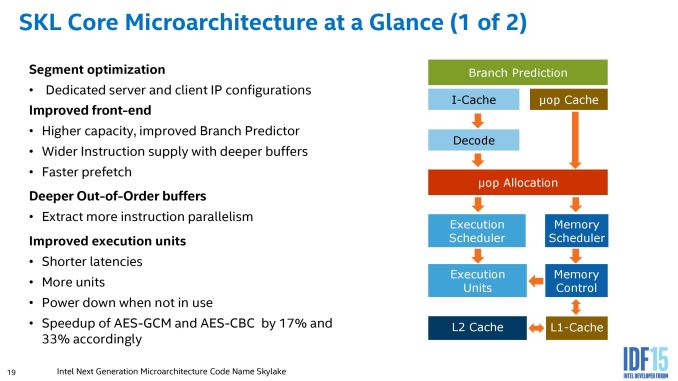
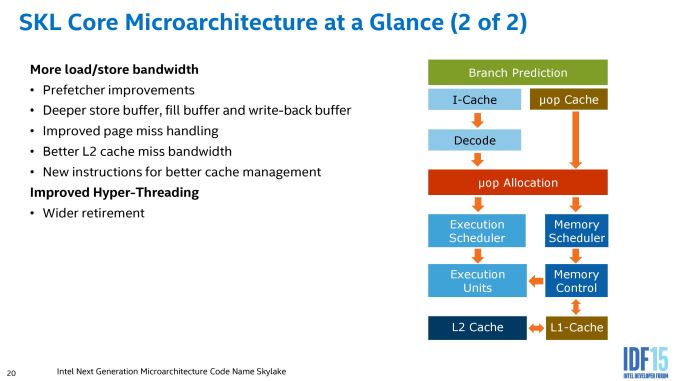
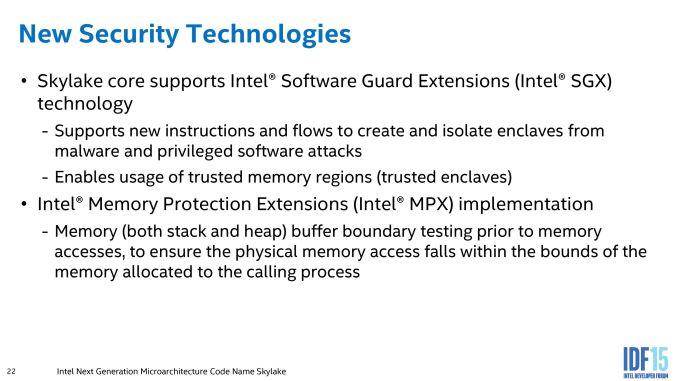
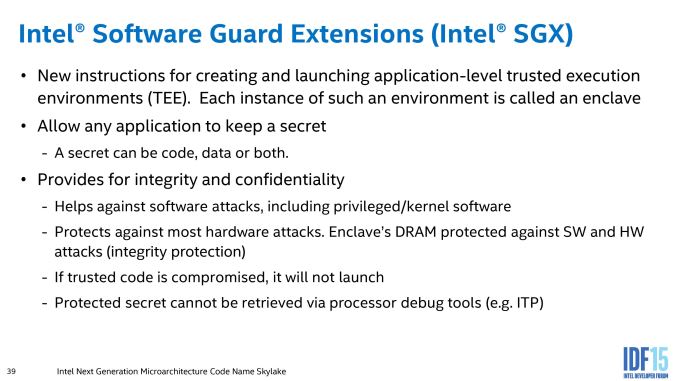






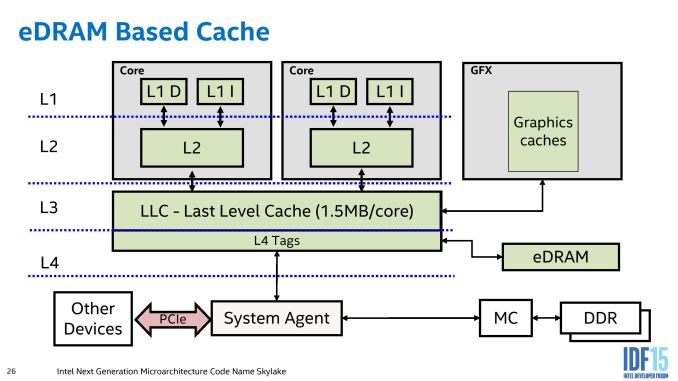









173 Comments
View All Comments
Xenonite - Thursday, September 3, 2015 - link
Actually, it seems that power consumption is the only thing that matters to consumers, even on the desktop.All this talk about AMD's lack of competition being the reason why we aren't seeing meaningful generational performance improvements is just that: talk.
The real thing that hampers performance progress is consumers' plain refusal to upgrade for performance reasons (even a doubling in performance is not economically viable to produce since no one, except for me it seems, will buy it).
Consumers only buy the lowest power system that they can afford. It has nothing to do with AMD.
Even if AMD released a CPU that is 4x faster than piledriver, it wouldn't change Intel's priority (nor would it help AMD's sales...).
IUU - Wednesday, September 2, 2015 - link
Sorry for my tone , but "I'm failing to see", how transistor count don't mean more to consumers than to anyone else.So, after 10 years of blissful carelessness(because duuude it's user experience dat matters, ugh..),
you will have everyone deceiving you on what they offer on the price point they offer. Very convenient, especially if they are not able to sustain an exponential increase in performance and passing to the next paradigm to achieve it.
Because untill very recently we have been seeing mostly healthy practices, despite the fact that you could always meet people pointing to big or small sins.
Big example, What's the need of an igp on a processor that consumes 90 watts, especially a gpu that is tragically subpar? To hide the fact they have nothing more to offer to the consumer, cpu dependent, at 90 watts(at the current market situation) and have an excuse for charging more on a
theoretically higher consuming and "higher performing" cpu?
Because, what bugs me is what if 6700k lacked the igp? Would it perform better without a useless igp dragging it down? I really don't know, but I feel it wouldn't.
Regarding the mobile solutions and the money and energy limited devices, the igp could really prove to be useful to a lot of people, without overloading their device with a clunky, lowly, discrete gpu.
xenol - Wednesday, September 2, 2015 - link
If the 6700K lacked the iGPU with no other modifications, it would perform exactly the same.MrSpadge - Wednesday, September 2, 2015 - link
Yes, it would perform exaclty the same (if the iGPU is not used, otherwise it needs memory bandwidth). But the chip would run hotter since it would be a lot smaller. Si is not the best thermal conductor, but the presence of the iGPU spreads the other heat producers a bit.xenol - Wednesday, September 2, 2015 - link
I don't think that's how thermals in ICs work...MrSpadge - Wednesday, September 2, 2015 - link
Thermodynamics "work" and don't care if they're being applied to an IC or a metal brick. Silicon is a far better heat conductor than air, so even if the GPU is not used, it will transfer some of the heat from the CPU + Uncore to the heat spreader.My comment was a bit stupid, though, in the way that given how tightly packed the CPU cores and the uncore are, the GPU spreads none of them further apart from each other. It could have been designed like that, but according to the picture on one of first few pages it's not.
Xenonite - Thursday, September 3, 2015 - link
No, it wouldn't. You could easily spread out the cores by padding them with much more cache and doubling their speculative and parallel execution capabilities. If you up the power available for such out of order execution, the additional die space could easily result in 50% more IPC throughput.MrSpadge - Thursday, September 3, 2015 - link
50% IPC increase? Go ahead and save AMD, then! They've been trying that for years with probably billions of R&D budget (accumulated over the years), yet their FX CPUs with huge L3 don't perform significantly better than the APUs with similar CPU cores and no L3 at all.Xenonite - Thursday, September 3, 2015 - link
Yes, but I specifically mentioned using that extra cache to feed the greater amount of speculative execution units made available by the removal of the iGPU.Sadly, AMD can't use this strategy because Global Foundaries' and TSMC's manufacturing technology cannot fit the same amount of transistors into a given area, as Intel's can.
Furthermore, their yields for large dies are also quite a bit lower and AMD really doesn't have the monetary reserves to produce such a high-risk chip.
Also, the largest fraction of that R&D budget went into developing smaller, cheaper and lower power processors to try and enter the mobile market, while almost all of the rest went into sacrificing single threaded design (such as improving and relying more on out of order execution, branch prediction and speculative execution) to design Bulldozer-like, multi-core CPUs (which sacrifice a large portion of die area, that could have been used to make a low amount of very fast cores, to implement a large number of slow cores).
Lastly, I didn't just refer to L3 cache when I suggested using some of the free space left behind by the removal of the iGPU to increase the amount of cache. The L1 and L2 caches could have been made much larger, with more associativity to further reduce the amount and duration of pipeline stalls, due to not having a data dependancy in the cache.
Also, while it is true that the L3 cache did not make much of a difference in the example you posted, its also equally true that cache performance becomes increasingly important as a CPU's data processing throughput increases.
Modern CPU caches just seem to have stagnated (aside from some bandwidth inprovements every now and then), because our CPU cores haven't seen that much of a performance upgrade since the last time the caches have been improved.
Once a CPU gets the required power and transistor budgets for improved out of order performance, the cache will need to be large enough to hold all the different datasets that a single core is working on at the same time (which is not a form a multi-threading in case you were wondering), while also being fast enough to service all of those units at once, without adversely affecting any one set of calculations.
techguymaxc - Wednesday, September 2, 2015 - link
Your representation of Skylake's CPU/IPC performance is inaccurate and incomplete due to the use of the slowest DDR4 memory available. Given the nature of DDR4 (high bandwidth, high latency), it is an absolute necessity to pair the CPU with high clockspeed memory to mitigate the latency impairment. Other sites have tested with faster memory and seen a much larger difference between Haswell and Skylake. See Hardocp's review, (the gaming section specifically) as well as Techspot's review (page 13, memory speed comparison). Hardocp shows Haswell with 1866 RAM is actually faster than Skylake with 2133 RAM in Unigine Heaven and Bioshock Infinite @ lowest quality settings (to create a CPU bottleneck). I find Techspot's article particularly interesting in that they actually tested both platforms with fast RAM. In synthetic testing (Sandra 2015) Haswell with 2400 DDR3 has more memory bandwidth than Skylake with 2666 DDR4, it is not until you pair Skylake with 3000 DDR4 that it achieves more memory bandwidth than Haswell with 2400 DDR3. You can see here directly the impact that latency has, even on bandwidth and not just overall performance. Furthermore in their testing, Haswell with 2400 RAM vs. Skylake with 3000 RAM shows Haswell being faster in Cinebench R15 multi-threaded test (895 vs. 892). Their 7-zip testing has Haswell leading both Skylake configurations in a memory-bound workload (32MB dictionary) in terms of instructions per second. Finally, in a custom Photoshop workload Haswell's performance is once again sandwiched between the two Skylake configurations.Clearly both Haswell and Skylake benefit from faster memory. In fact, Skylake should ideally be paired with > 3000 DDR4 as there are still scenarios in which it is slower than Haswell with 2400 DDR3 due to latency differences.
Enthusiasts are also far more likely to buy faster memory than the literal slowest memory available for the platform, given the minimal price difference. Right now on Newegg one can purchase a 16GB DDR3 2400 kit (2x8) for $90, a mere $10 more than an 1866 16GB kit. With DDR4 the situation is only slightly worse. The cheapest 16GB (2x8) 2133 DDR4 kit is $110, and 3000 goes for $135. It is also important to note that these kits have the same (primary) timings with a CAS latency of 15.
So now we come to your reasoning for pairing Skylake with such slow RAM, and that of other reviewers, as you are not the only one to have done this. Intel only qualified Skylake with DDR4 up to 2133 MT/s. Why did they do this? To save time and money during the qualification stage leading up to Skylake's release. It is not because Skylake will not work with faster RAM, there isn't an unlocked Skylake chip in existence that is incapable of operating with at least 3000 RAM speed, and some significantly higher. Hardocp was able to test their Skylake sample (with no reports of crashing or errors) with the fastest DDR4 currently available today, 3600 MT/s. I have also heard anecdotally from enthusiasts with multiple samples that DDR4 3400-3600 seems to be the sweet spot for memory performance on Skylake.
In conclusion, your testing method is improperly formed, when considered from the perspective of an enthusiast whose desire is to obtain the most performance from Skylake without over-spending. Now, if you believe your target audience is not in fact the PC enthusiast but instead a wider "mainstream" audience, I think the technical content of your articles easily belies this notion.